This
is an example of a recent Zeiss Historica Article
After
Dresden: the migration of the Contax to Jena and Kiev
Over the years, I have
seen much speculation on what happened to the Zeiss Ikon production of cameras
after the Second World War. There was certainly a loss of production at all
locations for a variety of reasons: the conversion from war materials manufacture
was difficult to reverse, there was bomb damage at almost all locations but
most seriously in Dresden and Berlin and the "Demontage" or dismantling
and expropriation of their facilities in Dresden and Berlin by the Russians
as war reparations. I have seen recent books and articles about the Kiev camera
which while very thorough did not address many issues. This was because they
were based on observation of the products and advertising. The fact that Zeiss
Ikon went out of the camera business in 1972 and the remnants of post war Zeiss
Ikon in Dresden were dispersed into a series of various "kombinats"
under an East German communist government have left pretty much next to nothing
in terms of adequate historical documentation. Since this happened 55 years
ago, the people directly involved with those events are not here to talk about
it. Therefore, I resolved to attempt to make an earnest attempt to summarize
what I knew and what I could find out about some of these mysteries. To this
end, I made a true pilgrimage to Germany to search out what could be found.
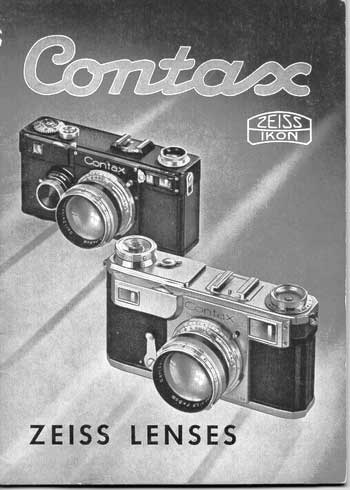 First,
I visited Dresden and Jena. In Dresden, I found that almost all of the buildings
of the former Zeiss Ikon had been demolished with only two buildings of
the Ernemann location at the corner of Junghans and Schandauer Streets left
standing. The main building and "building 59" had been turned
over to the various postwar camera entities that we can best now call VEB
Pentacon. The outside of the building had been stripped of all of the trademarks
of Ernemann and Zeiss Ikon. The interior walls of the offices inside had
been covered with nearly a quarter inch thick layer of white paint to obliterate
any visual references to the capitalistic past. The main building, which
is now the home of the Dresden Technical Museum, has occupied the former
office area on the first floor and has stripped away that white paint and
restored the Ernemann offices to their near original condition. The marble
floor still has the old Ernemann trademark in the middle of the entrance
floor. The walls have been returned to the dark green with white trim of
earlier times, the beautiful hardwood paneling has been restored and a bust
of the founder, Heinrich Ernemann is now in the lobby of the building. Over
each of the office doors is a large brass inlaid Ernemann trademark of a
camera shutter. The city of Dresden is trying very hard to bring the museum
to life but there are little surplus funds for the museum. However, it does
house several interesting technical exhibits including photography and is
well worth a visit. In November 2000, a distinguished colloquium was held
on the history of Zeiss Ikon. First,
I visited Dresden and Jena. In Dresden, I found that almost all of the buildings
of the former Zeiss Ikon had been demolished with only two buildings of
the Ernemann location at the corner of Junghans and Schandauer Streets left
standing. The main building and "building 59" had been turned
over to the various postwar camera entities that we can best now call VEB
Pentacon. The outside of the building had been stripped of all of the trademarks
of Ernemann and Zeiss Ikon. The interior walls of the offices inside had
been covered with nearly a quarter inch thick layer of white paint to obliterate
any visual references to the capitalistic past. The main building, which
is now the home of the Dresden Technical Museum, has occupied the former
office area on the first floor and has stripped away that white paint and
restored the Ernemann offices to their near original condition. The marble
floor still has the old Ernemann trademark in the middle of the entrance
floor. The walls have been returned to the dark green with white trim of
earlier times, the beautiful hardwood paneling has been restored and a bust
of the founder, Heinrich Ernemann is now in the lobby of the building. Over
each of the office doors is a large brass inlaid Ernemann trademark of a
camera shutter. The city of Dresden is trying very hard to bring the museum
to life but there are little surplus funds for the museum. However, it does
house several interesting technical exhibits including photography and is
well worth a visit. In November 2000, a distinguished colloquium was held
on the history of Zeiss Ikon. |
I could find no records
in Dresden to speak of but on my visit to the Carl Zeiss archives in Jena, I
did find some solid information. These were mostly with regard to the post war
activities of the Russians to take the assets of Zeiss Ikon and Carl Zeiss to
begin their own optical and camera industries. On my return, I reviewed past
articles by member Sam Sherman in both our and other publications. Since I now
have very specific Contax and Kiev information from the archives in Jena, I
reviewed my conversational notes and letters exchanged with the late Zeiss Ikon
designers, Hubert Nerwin and Hans Padelt, both of whom had come to the US after
the war. I have reviewed the other known books on the subject and some of the
work (in German) of Bernd Otto and Kurt Jüttner, and Mr. Jüttner's
has kindly supplied his detailed lifetime listing of his observations of Jena
Contax cameras. Now, I submit the following summation of the facts, as I understand
them.
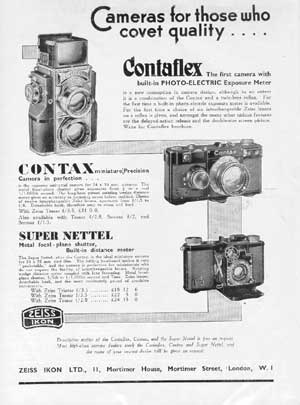
I will start with
the Contax. The prewar Contax production was solely done in the former
Ica facility at 76 Schandauer St. in Dresden. The Ernemann buildings were
primarily used to manufacture amateur and profession cinematic apparatus
and darkroom equipment. The production of the Contax II & III was
greatly curtailed starting in 1938 and during the war years with most
all of the small number of cameras going for governmental purposes. In
the last two years of the war, the heavy Allied bombing of Dresden destroyed
key parts of the Ica facility and the damage to the Contax rangefinder
production was so complete that it was not possible to be continued without
reconstructing the production line. The bombing was so severe that the
company safe, which was located in the basement, was destroyed. This was
were all of the models and drawings for prototypes were kept. The production
line on the upper floors could not be reconstructed during the war.
In 1945, as part
of their war reparations, the Russians demanded that the production of
the Contax camera be totally transferred to a factory in the USSR. This
"new" camera was initially to be called the Volga. As a result
of this, Contax rangefinder production was forever ended in Dresden. It
is not totally clear if this is was a condition of the reparation agreement
but it certainly seems to be. Why would the Russians permit direct competition
in a location that they controlled. One point that must be made is that
this confiscation of the Contax seems to have been quite well conceived
since it was implemented as soon as the Russians came to Jena and Dresden.
The management of the Zeiss companies understood their situation and immediately
fell into line to accomplish the task.
|
Contrary to prior writings,
the Russians were quite specific and thorough in their demands. They demanded
complete blueprints/technical drawings. In addition, since there was no Contax
production line then in operation, they demanded that the production line be
started in East Germany. This was to insure the quality of the transferred materials
and Russia's new camera. It was to produce a certain number of Contax and other
photographic products and accessories before the production equipment and materials
would then transported to the "Volga factory. Zeiss Ikon supplied staff
and materials to this end to Carl Zeiss. Remember that Zeiss Ikon was a subsidiary
of Carl Zeiss but the Russians wanted Carl Zeiss to be the agent of producing
the assembly line.
|
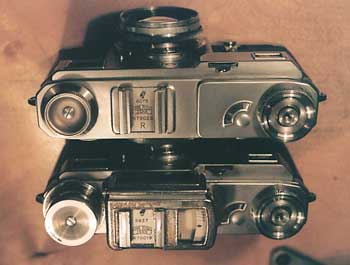 I
was able to review a book thick with such detailed drawings that still
exists in the Betreib Archiv Carl Zeiss (BACZ) in Jena. It is a mixture
of technical drawings down to each and every component part and part groupings.
Each drawing is dated and most of them fall into the immediate postwar
years, although there are just a few prewar and war time drawings. Most
of these drawings are marked Carl Zeiss Jena while, again, only a few
are marked Zeiss Ikon (Dresden). This seems to confirm the fact that this
was not identical to the prewar Dresden Contax. I looked carefully through
this collection of technical drawings and I did not see a bezel trademark
design for the Kiev or the Volga but from the tenor of the accompanying
documents I had clearly expected the name of the trademark to be Volga
and not Kiev. I
was able to review a book thick with such detailed drawings that still
exists in the Betreib Archiv Carl Zeiss (BACZ) in Jena. It is a mixture
of technical drawings down to each and every component part and part groupings.
Each drawing is dated and most of them fall into the immediate postwar
years, although there are just a few prewar and war time drawings. Most
of these drawings are marked Carl Zeiss Jena while, again, only a few
are marked Zeiss Ikon (Dresden). This seems to confirm the fact that this
was not identical to the prewar Dresden Contax. I looked carefully through
this collection of technical drawings and I did not see a bezel trademark
design for the Kiev or the Volga but from the tenor of the accompanying
documents I had clearly expected the name of the trademark to be Volga
and not Kiev.
The documents state
that the production line was not in Jena proper but rather in Saalfeld
which is about an hour's drive from Jena. This would be the site where
the Werra cameras from VEB Carl Zeiss Jena would later be manufactured.
It would seem that the Jena Contax, associated lenses and accessories
were all manufactured there. It is my strong certainly that it is these
Contax cameras from this pre-Kiev production in Saalfeld were to become
known as the Jena Contax. (See C. Barringer's article from Spring 1999.)
|
As early as November
of 1945, the Russians stated that they wanted Carl Zeiss (not Zeiss Ikon) to
provide them with sufficient knowledge, technical drawings, and instruction
for the Russians in Kiev. The production machinery and design process were to
be designed to produce 5,000 cameras per month in that Russian location. They
required 8 complete sets of drawings and a set number of complete samples of
the camera and each of the lenses and accessories.
The specific lenses that
they wanted to be able to manufacture were also to have the same number of drawings
and samples. The specific lenses and accessories named in the Soviet requirements
were these ten:
1. Biogon
1:2.8/ 3.5 cm, 2. Sonnar 1: 2.8/ 18 cm, 3. Sonnar 1: 2/ 5 cm, 4. Sonnar 1: 4/
30 cm 5. Sonnar 1: 1.5/ 5 cm, 6. Fernobjektiv 1:8/ 50 cm, 7. Sonnar 1: 2/ 8.5
cm, 8. Tessar 1:8/ 2.8 cm and 10. Sonnar 1: 4/ 13.5 cm
Based on detailed research
from Charles Barringer, the rare Carl Zeiss Herar lens for the Contax seems
to have traveled with this material or was sold almost exclusively to the countries
associated with the Eastern bloc but there was no interest in manufacturing
it. Not all of these lenses ultimately appeared to be manufactured in Russia
but the plans were supplied in any case.
They also wanted the
universal finder, the Flektoskop, most Contax accessories as well as projection
and darkroom equipment. Now, it is not clear that the Russians finally decided
to make each and every of these items. In fact, the evidence suggests that they
did not. Based on the clear organization of the taking of the reparations and
the Germans acceptance of it, the general process seems to have been done as
planned and to a schedule. The stories of equipment rusting in train yards in
various Russian and Polish locations seem to be mythological at least in respect
to this camera. There were other products demanded as well. These included reproduction
devices, cinematic cameras and projectors, darkroom equipment and a number of
slide projecting apparatus. The process was overseen by a Russian officer, Major
Turuegin.
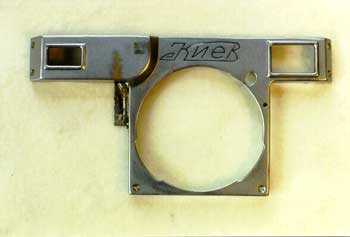 It
is clear that Zeiss Ikon in Dresden never again manufactured a rangefinder
Contax and, instead, concentrated on the newly designed Contax SLR as finalized
by Wilhelm Winzenburg based on the work of Hubert Nerwin and others from
1938-1946. Winzenburg was not a member of the prewar camera design team
for Zeiss Ikon. In the prewar years, he was the team leader for those who
designed darkroom equipment. The swift construction of the Contax SLR suggests
that the tool and die manufacturing facility in the old Wünsche (a
pre-Zeiss Ikon and pre-Ica company) plant located in Reick on the outskirts
of Dresden was not damaged or was able to be activated soon after the end
of the war. Pre war Zeiss Ikon had used this location to manufacture almost
all the machinery, tools and dies for its own assembly lines before the
war. I have been fortunate to find two different catalogs devoted to this
unfamiliar line of Zeiss Ikon businesses. It
is clear that Zeiss Ikon in Dresden never again manufactured a rangefinder
Contax and, instead, concentrated on the newly designed Contax SLR as finalized
by Wilhelm Winzenburg based on the work of Hubert Nerwin and others from
1938-1946. Winzenburg was not a member of the prewar camera design team
for Zeiss Ikon. In the prewar years, he was the team leader for those who
designed darkroom equipment. The swift construction of the Contax SLR suggests
that the tool and die manufacturing facility in the old Wünsche (a
pre-Zeiss Ikon and pre-Ica company) plant located in Reick on the outskirts
of Dresden was not damaged or was able to be activated soon after the end
of the war. Pre war Zeiss Ikon had used this location to manufacture almost
all the machinery, tools and dies for its own assembly lines before the
war. I have been fortunate to find two different catalogs devoted to this
unfamiliar line of Zeiss Ikon businesses. |
|
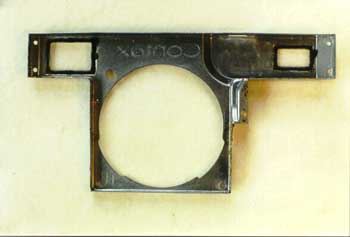 According
to a February 26, 1946 internal memo, the Saalfeld works were to make
cameras at an accelerated rate: 300 each in September and October and
500 each in November and December 1946 and 700 in January, 800 in February
and 600 in March 1947. This same memo shows specifically, which machines
by type and number were to be transported to Kiev. This would mean that
3800 Jena Contaxes were scheduled to be made. The actual production could
have been lower or higher. According
to a February 26, 1946 internal memo, the Saalfeld works were to make
cameras at an accelerated rate: 300 each in September and October and
500 each in November and December 1946 and 700 in January, 800 in February
and 600 in March 1947. This same memo shows specifically, which machines
by type and number were to be transported to Kiev. This would mean that
3800 Jena Contaxes were scheduled to be made. The actual production could
have been lower or higher.
|
So, the Saalfeld location
did construct the Jena Contaxes and the facility was moved in its entirety to
the "Volga" plant in Kiev. Then, the East German government devoted
its resources to restocking Carl Zeiss locations in Jena and Saalfeld after
the "Demontage" when 98% of all the production equipment in every
factory was physically taken to Russia. Dr. Hemscheidt was a prominent participant
in this process although he headed the Zeiss Ikon plant at the old Goerz locations
in what was West Berlin. I found a telegram from the director of Carl Zeiss
Oberkochen, Heinz Küppenbender, regarding the "Kontaxgruppe"
shows that he was fully aware of these activities. It specifically said to get
on with supporting other Zeiss products and forget about manufacturing the Contax
rangefinder in Dresden.
The Russians did take
a good number of Carl Zeiss and Zeiss Ikon technicians and managers with them
to assure the startup of the new operation. I did not find any direct indication
of whether Winzenburg was taken to Russia, remained in Dresden or came to Jena.
Remember, while Zeiss Ikon was a subsidiary of the Carl Zeiss firm, it was run
independent of Carl Zeiss Jena. Their records were separate and only correspondence
between them on lens design, optical finders and how their cameras would be
used on microscopes or telescopes would have been retained in the firm's records.
Unfortunately, I did not have time enough to get into those matters on this
trip.
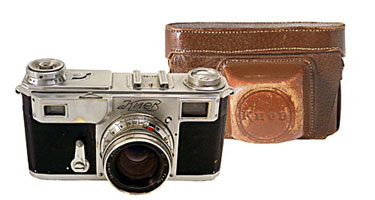 So,
the Kiev began to be manufactured in the "Volga" factory as scheduled
in 1947. The name Kiev was used instead of Volga. Many of the early Kiev
cameras have markings that were clearly originally marked Contax originally.
This means that the transfer to Kiev from Saalfeld included the stock of
individual components of many of the cameras. These had already been prepared
to be assembled in Kiev with the trainee Russian craftsmen under the tutelage
of the German technicians who were taken there. Indeed, many of the early
Kiev lenses seem to have serial numbers in the same series as Carl Zeiss
Jena lenses. So,
the Kiev began to be manufactured in the "Volga" factory as scheduled
in 1947. The name Kiev was used instead of Volga. Many of the early Kiev
cameras have markings that were clearly originally marked Contax originally.
This means that the transfer to Kiev from Saalfeld included the stock of
individual components of many of the cameras. These had already been prepared
to be assembled in Kiev with the trainee Russian craftsmen under the tutelage
of the German technicians who were taken there. Indeed, many of the early
Kiev lenses seem to have serial numbers in the same series as Carl Zeiss
Jena lenses. |
.
The new Contax SLR camera
from Zeiss Ikon in Dresden came to market in almost this same time frame since
they had the asset of the Reick factory to produce the assembly lines. However,
the West German products from Zeiss Ikon Stuttgart were far behind. The designers
had to go forward without technical drawings and started the design of the camera,
the tools and the production line from the very beginning. Remember also that
they did not have the Reick plant to supply the components or the tools as they
had before the war. The y had to content with other suppliers in the most difficult
days after the war when materials were scarce. These suppliers were not dedicated
to Zeiss Ikon as Reick had been and so there was no prior association or experience.
In addition, Stuttgart had not made any 35 mm cameras before the war, their
main products were the roll film cameras such as the Nettar, Ikonta and the
Super Ikonta. They had to resupply the Berlin locations of Zeiss Ikon. The Contax
IIa & IIIa came several years later in 1951. A few years later, the new
Contaflex 35mm SLR came as well. These were very successful product lines and,
with regard to the Contaflex, in spite of its technical limitations.
The Stuttgart Contax
had a modified metal shutter similar to the prewar version but improved. The
small 35 Ikonta/Contina/Contessa cameras came to market first and were designed
in detail by Nerwin before he left for Rochester, NY in 1947. These cameras
clearly show the design elements of a typical Nerwin camera: compact, fits nicely
in the hand and innovative in construction.
From observations, it
is clear that there were significant internal differences in the prewar Contax
and the Jena Contax and the resulting Kiev as well. From the exterior, there
is little of this to be seen but there are differences internally based on a
review in Jena and the new drawings before starting the new production line.
I found an accounting of what Carl Zeiss properties were sent to Russia that
was sent to the East German government. This was to assist the East German government
to replace the removed equipment and restart these as new businesses in Jena
and Dresden. However, at the same time, I know that the West German Carl Zeiss
was sending specific machinery from locations in the non-Russian Allied Zones
to Jena and Dresden. These were mostly from the Winkel location in Göttingen
and the Hensoldt location in Wetzlar. I would expect that the Zeiss Ikon Reick
facility would be active in East Germany and was able to supply to both companies.
I am not certain that the other Zeiss owned firms in what would become West
Germany were able to help. These were Deckel (Compur) in Munich and Gauthier
(Prontor) in Calmbach. They could have supplied such equipment but I would presume
that they were looking for paying customers as well. These shutter-making firms
also were very active in the manufacturing of machine tools. It should be noted
that Deckel had also suffered significant bomb damage.
In the two recent books
on this camera ( Peter Hennig's Historien Om Contax - in Swedish and Minoru
Sasaki's Contax to ????) there is information that has not appeared in these
pages before. Most of it deals with the internals of the early Kiev cameras.
As I have stated there are distinct internal differences between the early Kievs.
Some reflect the parts of the Zeiss Ikon Contax but most reflect the Jena Contax.
This probably means that parts from Zeiss Ikon Dresden were sent to Jena and
used there as training materials for the Russian technicians either in Saalfeld/Jena
or in Kiev. This can best be seen in the pictures in these two books of the
dismantled front plate of a Kiev. It is not the familiar Kiev with both Cyrillic
and Latin letters nor the block Cyrillic print (????) but rather a script version
that was new to me. On the internal side of the front plate, it is clear that
the Contax trademark had been there well before the Kiev. However, it seems
that many Dresden parts were used up into 1948. If we want to carry Peter's
analogy forward we can call some of the early Russian cameras "Dresden
Kievs. This means many activities are possible from training vehicle in both
places or just judicious use of every single available part in the era of little
raw materials. It is clear that this materials shortage led to many strange
cameras and lenses during and immediately after the war. However, another point
of interest from Hennig is that the relationship between his native Sweden and
Germany during the war years was different from any other. The Swedes made the
best ball bearings in that day and had ample iron ore. As a result, there was
open trade between the two counties and the Swedish market was able to buy almost
anything from Germany. He says that it was possible for a Swedish citizen to
buy a new Contax II camera with the wartime T coated lenses during the war up
until 1946.
The Carl Zeiss records
also indicate that the Russians wanted other products as well. There was the
movement of Carl Zeiss microscope facilities to the area near St. Petersburg.
This new firm named "LOMO" is active in microscope manufacture to
the present day. I know that famous Zeiss scientist Dr. A. Sonnefeld spent 5
years in Russia building a facility with regard to Astronomy. The Zeiss Ikon
specialist in photocells, Paul Görlich, also spent five years in Russia
and returned to work in Jena and not in the Dresden photographic kombinats.
Clearly, there were Russian binocular manufacturing locations that were aided
by the reparations from Carl Zeiss.
|
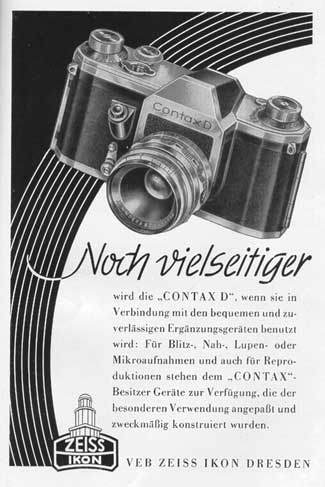 The
lens designs were pretty static in the years immediately after the war
because most of the world famous Carl Zeiss designers went separate ways.
Ludwig Bertele had moved to Steinheil in 1943 and left Germany to go to
Wild in Switzerland in 1945. Robert Richter and Willy Merte went to Heidenheim
with the US Army. Soon after, Merte and several of the lower level designers
accepted American military contracts to go to the US. Ernst Wandersleb
was quite advanced in years and had been forced outside of the Zeiss plant
in Jena since before the start of the war due to his Jewish wife. Hans
Sauer would become the leader in Western Germany and soon began a new
era of greatness for Zeiss in lens design (see the Kämmerer article
in this issue). A new personality, Harry Zöllner who had earlier
apprenticed at Zeiss returned to Jena from a position Voigtländer
after the end of the war to become the long term head of the Carl Zeiss
East German lens design effort. The
lens designs were pretty static in the years immediately after the war
because most of the world famous Carl Zeiss designers went separate ways.
Ludwig Bertele had moved to Steinheil in 1943 and left Germany to go to
Wild in Switzerland in 1945. Robert Richter and Willy Merte went to Heidenheim
with the US Army. Soon after, Merte and several of the lower level designers
accepted American military contracts to go to the US. Ernst Wandersleb
was quite advanced in years and had been forced outside of the Zeiss plant
in Jena since before the start of the war due to his Jewish wife. Hans
Sauer would become the leader in Western Germany and soon began a new
era of greatness for Zeiss in lens design (see the Kämmerer article
in this issue). A new personality, Harry Zöllner who had earlier
apprenticed at Zeiss returned to Jena from a position Voigtländer
after the end of the war to become the long term head of the Carl Zeiss
East German lens design effort.
I did not find
any documentation on the movement of the Super Ikonta like camera named
the Moskva to Russia. However, the Reick plant would have had all of the
blueprints and materials to transfer. Seemingly, Zeiss Ikon Dresden did
not try to duplicate the Super Ikonta which supports the no conflict of
business with the Russians. I welcome any additional information that
anyone might have on this subject. I still highly recommend the Minoru
Sasaki publication (From Contax to Kiev) which I reviewed in our last
issue to see the best definition of these cameras and their differences.
|
Summary: Zeiss Ikon Stuttgart
was able to resume production rather quickly of the bellows style cameras such
as the Ikonta and Super Ikonta and within 3-4 years the bellows based Ikonta/Contina/Contessa
family was well. The New Contax IIa and IIIa camera to market in 1951 and a
few years later the Contaflex SLR. Zeiss Ikon Berlin was able to produce the
Box Tengor, the Ikoflex cameras and resume the production of key/lock security
systems and calculators in the late 1940s. Zeiss Ikon Dresden handed off the
Contax rangefinder camera to Carl Zeiss Jena who in turn handed it off to the
Arsenal factory outside of Kiev in 1947. It used the Reick facility to set up
a production line for a bellows camera very similar to the Ikonta named the
Ercona and initiated production of the prewar 35mm Tenax I camera with a newly
formatted F/3.5 Tessar 37.5 cm. The SLR Contax was produced originally using
the Zeiss Ikon logo and after the 1954 West German court verdict (where they
lost the ability to use that trademark), they moved to the Ernemann tower logo
with the letters ZI and later the ZI was dispensed with. The Contax trademark
was also lost in 1954 but was used in certain parts of the world and not in
others. This Contax trademark was changed to Pentacon, which stood for Pentaprism
Contax.
I thank many people who
contributed to this new information and welcome any other pictures, data or
opinions in this very interesting area of Zeiss history.
Larry Gubas
- Zeiss Historica, Spring 2001
An
update to this article with some corrections to this material appears in the
Fall 2002 edition of Zeiss Historica Journal
Our site
is located on the following pages. Click on the name of each area to go to that
page:
1.
An overview of historical Zeiss Companies and a list of their collectibles
2.
Our Zeiss Historica Publications
3.
A sample article - The Contax camera's migration to Kiev, Ukraine
4.
A second sample article - An unusual Contax I
5.
An index to all of our published articles
6. Links
to other interesting web sites related to Zeiss and photography
7.
Membership Information
8.
Famous Zeiss Designers and Personalities
 First,
I visited Dresden and Jena. In Dresden, I found that almost all of the buildings
of the former Zeiss Ikon had been demolished with only two buildings of
the Ernemann location at the corner of Junghans and Schandauer Streets left
standing. The main building and "building 59" had been turned
over to the various postwar camera entities that we can best now call VEB
Pentacon. The outside of the building had been stripped of all of the trademarks
of Ernemann and Zeiss Ikon. The interior walls of the offices inside had
been covered with nearly a quarter inch thick layer of white paint to obliterate
any visual references to the capitalistic past. The main building, which
is now the home of the Dresden Technical Museum, has occupied the former
office area on the first floor and has stripped away that white paint and
restored the Ernemann offices to their near original condition. The marble
floor still has the old Ernemann trademark in the middle of the entrance
floor. The walls have been returned to the dark green with white trim of
earlier times, the beautiful hardwood paneling has been restored and a bust
of the founder, Heinrich Ernemann is now in the lobby of the building. Over
each of the office doors is a large brass inlaid Ernemann trademark of a
camera shutter. The city of Dresden is trying very hard to bring the museum
to life but there are little surplus funds for the museum. However, it does
house several interesting technical exhibits including photography and is
well worth a visit. In November 2000, a distinguished colloquium was held
on the history of Zeiss Ikon.
First,
I visited Dresden and Jena. In Dresden, I found that almost all of the buildings
of the former Zeiss Ikon had been demolished with only two buildings of
the Ernemann location at the corner of Junghans and Schandauer Streets left
standing. The main building and "building 59" had been turned
over to the various postwar camera entities that we can best now call VEB
Pentacon. The outside of the building had been stripped of all of the trademarks
of Ernemann and Zeiss Ikon. The interior walls of the offices inside had
been covered with nearly a quarter inch thick layer of white paint to obliterate
any visual references to the capitalistic past. The main building, which
is now the home of the Dresden Technical Museum, has occupied the former
office area on the first floor and has stripped away that white paint and
restored the Ernemann offices to their near original condition. The marble
floor still has the old Ernemann trademark in the middle of the entrance
floor. The walls have been returned to the dark green with white trim of
earlier times, the beautiful hardwood paneling has been restored and a bust
of the founder, Heinrich Ernemann is now in the lobby of the building. Over
each of the office doors is a large brass inlaid Ernemann trademark of a
camera shutter. The city of Dresden is trying very hard to bring the museum
to life but there are little surplus funds for the museum. However, it does
house several interesting technical exhibits including photography and is
well worth a visit. In November 2000, a distinguished colloquium was held
on the history of Zeiss Ikon. 
 I
was able to review a book thick with such detailed drawings that still
exists in the Betreib Archiv Carl Zeiss (BACZ) in Jena. It is a mixture
of technical drawings down to each and every component part and part groupings.
Each drawing is dated and most of them fall into the immediate postwar
years, although there are just a few prewar and war time drawings. Most
of these drawings are marked Carl Zeiss Jena while, again, only a few
are marked Zeiss Ikon (Dresden). This seems to confirm the fact that this
was not identical to the prewar Dresden Contax. I looked carefully through
this collection of technical drawings and I did not see a bezel trademark
design for the Kiev or the Volga but from the tenor of the accompanying
documents I had clearly expected the name of the trademark to be Volga
and not Kiev.
I
was able to review a book thick with such detailed drawings that still
exists in the Betreib Archiv Carl Zeiss (BACZ) in Jena. It is a mixture
of technical drawings down to each and every component part and part groupings.
Each drawing is dated and most of them fall into the immediate postwar
years, although there are just a few prewar and war time drawings. Most
of these drawings are marked Carl Zeiss Jena while, again, only a few
are marked Zeiss Ikon (Dresden). This seems to confirm the fact that this
was not identical to the prewar Dresden Contax. I looked carefully through
this collection of technical drawings and I did not see a bezel trademark
design for the Kiev or the Volga but from the tenor of the accompanying
documents I had clearly expected the name of the trademark to be Volga
and not Kiev. It
is clear that Zeiss Ikon in Dresden never again manufactured a rangefinder
Contax and, instead, concentrated on the newly designed Contax SLR as finalized
by Wilhelm Winzenburg based on the work of Hubert Nerwin and others from
1938-1946. Winzenburg was not a member of the prewar camera design team
for Zeiss Ikon. In the prewar years, he was the team leader for those who
designed darkroom equipment. The swift construction of the Contax SLR suggests
that the tool and die manufacturing facility in the old Wünsche (a
pre-Zeiss Ikon and pre-Ica company) plant located in Reick on the outskirts
of Dresden was not damaged or was able to be activated soon after the end
of the war. Pre war Zeiss Ikon had used this location to manufacture almost
all the machinery, tools and dies for its own assembly lines before the
war. I have been fortunate to find two different catalogs devoted to this
unfamiliar line of Zeiss Ikon businesses.
It
is clear that Zeiss Ikon in Dresden never again manufactured a rangefinder
Contax and, instead, concentrated on the newly designed Contax SLR as finalized
by Wilhelm Winzenburg based on the work of Hubert Nerwin and others from
1938-1946. Winzenburg was not a member of the prewar camera design team
for Zeiss Ikon. In the prewar years, he was the team leader for those who
designed darkroom equipment. The swift construction of the Contax SLR suggests
that the tool and die manufacturing facility in the old Wünsche (a
pre-Zeiss Ikon and pre-Ica company) plant located in Reick on the outskirts
of Dresden was not damaged or was able to be activated soon after the end
of the war. Pre war Zeiss Ikon had used this location to manufacture almost
all the machinery, tools and dies for its own assembly lines before the
war. I have been fortunate to find two different catalogs devoted to this
unfamiliar line of Zeiss Ikon businesses.  According
to a February 26, 1946 internal memo, the Saalfeld works were to make
cameras at an accelerated rate: 300 each in September and October and
500 each in November and December 1946 and 700 in January, 800 in February
and 600 in March 1947. This same memo shows specifically, which machines
by type and number were to be transported to Kiev. This would mean that
3800 Jena Contaxes were scheduled to be made. The actual production could
have been lower or higher.
According
to a February 26, 1946 internal memo, the Saalfeld works were to make
cameras at an accelerated rate: 300 each in September and October and
500 each in November and December 1946 and 700 in January, 800 in February
and 600 in March 1947. This same memo shows specifically, which machines
by type and number were to be transported to Kiev. This would mean that
3800 Jena Contaxes were scheduled to be made. The actual production could
have been lower or higher. So,
the Kiev began to be manufactured in the "Volga" factory as scheduled
in 1947. The name Kiev was used instead of Volga. Many of the early Kiev
cameras have markings that were clearly originally marked Contax originally.
This means that the transfer to Kiev from Saalfeld included the stock of
individual components of many of the cameras. These had already been prepared
to be assembled in Kiev with the trainee Russian craftsmen under the tutelage
of the German technicians who were taken there. Indeed, many of the early
Kiev lenses seem to have serial numbers in the same series as Carl Zeiss
Jena lenses.
So,
the Kiev began to be manufactured in the "Volga" factory as scheduled
in 1947. The name Kiev was used instead of Volga. Many of the early Kiev
cameras have markings that were clearly originally marked Contax originally.
This means that the transfer to Kiev from Saalfeld included the stock of
individual components of many of the cameras. These had already been prepared
to be assembled in Kiev with the trainee Russian craftsmen under the tutelage
of the German technicians who were taken there. Indeed, many of the early
Kiev lenses seem to have serial numbers in the same series as Carl Zeiss
Jena lenses.  The
lens designs were pretty static in the years immediately after the war
because most of the world famous Carl Zeiss designers went separate ways.
Ludwig Bertele had moved to Steinheil in 1943 and left Germany to go to
Wild in Switzerland in 1945. Robert Richter and Willy Merte went to Heidenheim
with the US Army. Soon after, Merte and several of the lower level designers
accepted American military contracts to go to the US. Ernst Wandersleb
was quite advanced in years and had been forced outside of the Zeiss plant
in Jena since before the start of the war due to his Jewish wife. Hans
Sauer would become the leader in Western Germany and soon began a new
era of greatness for Zeiss in lens design (see the Kämmerer article
in this issue). A new personality, Harry Zöllner who had earlier
apprenticed at Zeiss returned to Jena from a position Voigtländer
after the end of the war to become the long term head of the Carl Zeiss
East German lens design effort.
The
lens designs were pretty static in the years immediately after the war
because most of the world famous Carl Zeiss designers went separate ways.
Ludwig Bertele had moved to Steinheil in 1943 and left Germany to go to
Wild in Switzerland in 1945. Robert Richter and Willy Merte went to Heidenheim
with the US Army. Soon after, Merte and several of the lower level designers
accepted American military contracts to go to the US. Ernst Wandersleb
was quite advanced in years and had been forced outside of the Zeiss plant
in Jena since before the start of the war due to his Jewish wife. Hans
Sauer would become the leader in Western Germany and soon began a new
era of greatness for Zeiss in lens design (see the Kämmerer article
in this issue). A new personality, Harry Zöllner who had earlier
apprenticed at Zeiss returned to Jena from a position Voigtländer
after the end of the war to become the long term head of the Carl Zeiss
East German lens design effort.